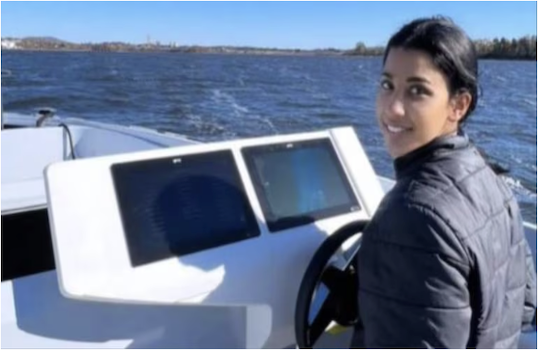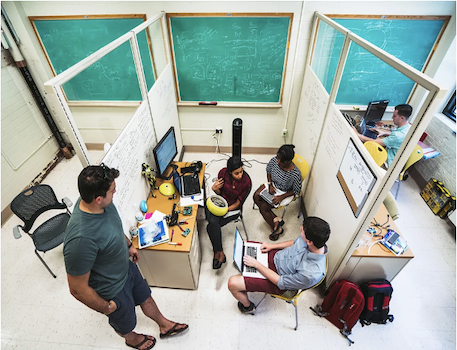
Sampriti Bhattacharyya was born on January 1st, 1987 in Kolkata, India, where she spent her childhood and teenage years. She was innately drawn to innovation and exploration, and was always fascinated in how technology could help solve what she referred to as “the world’s hardest challenges.” At just twelve years old, she became preoccupied with space exploration after becoming inspired by the Apollo Mission to the Moon. During her adolescence, Bhattachrayya learned about NASA, and gained exposure to space technology through movies and the Discovery channel. Hence, she discovered her passion for STEM at a young age, especially for math and physics.
However, Bhattacharyya was an average student and did not excel academically at South Point High School. She failed her physics class, leading her male physics and math teacher to tell her that she was better suited to become a housewife or work a subdued job as a woman. Despite all the discouragement from her teachers, Bhattacharyya's passion was strong and solid, and she decided to further pursue her education. She obtained a bachelor’s degree in technology and electrical engineering at a small community college, the West Bengal University of Technology. However, her home town did not have many opportunities for her to pursue her passion and to do much with her degree, and she did not have any connections to enhance her career. Throughout this challenging journey, Battacharyya created a mantra to help her continue with her ambitions: “If it’s not against the laws of physics, it’s possible”.

At twenty years old, her family bought their first computer that Bhattacharyya used to apply to internships in the United States. Through email, she applied to 540 internships in different companies but only 4 responded. Out of the 4 responses, only one had a particle physics and an accelerator laboratory that she was fascinated with: the Fermilab. The summer internship was located in Chicago and it was an opportunity that Bhattacharyya was able to secure. She then booked a flight and flew to the US to work as a research assistant at the Fermilab with only $200 in her pocket. This fortunate opportunity marked the beginning of Bhattacharyya’s journey to success and achieve the potential she did not know she had.
Her time at the Fermilab enhanced her passion for science, specifically coding and working with robotics. At the same time, she was able to go to Ohio State University through a scholarship and earned a Masters in Aerospace Engineering. She was then able to get an internship at NASA’s Ames Research Center, where she worked on autonomous aircraft, an aircraft that functions independently from a human pilot via on-board robotic systems. During her time in NASA, she also learned about the young entrepreneurs of Silicon Valley, especially Mark Zuckerberg, the CEO of Facebook. This sparked an inspiration for Bhattacharyya to start her own company, which would later manifest in her career. She completed a PhD in mechanical engineering at Massachusetts Institute of Technology.

However, in 2014, the tragic event of the Malaysian Airlines MH370 flight, became a turning point in Bhchattaryya’s career; the airplane had randomly vanished from the radar on March 8th, 2014 and it has still not been found today. This tragic event shifted her ambitions from space to ocean exploration. It was a defining moment in her life that helped her realize how underdeveloped maritime technology is, and how little is known about the oceans compared to space. "Why can't we have a bunch of robots with sensors on them look for it? Then you realise we know less about our oceans than the Moon's surface." This sparked her interest in maritime technology and ocean exploration. From then, her dream was to the next generation of maritime and seafaring.
In 2017, at twenty-eight years old, Bhattaccharyya launched Hydroswarm, a company that produced underwater drones that map ocean floors. The drone is the size of a football and its features include scanning for lost planes and measuring oil spills or radiation under the sea. However, without any explanations, the company was shut down in June, 2019. But her ambition of creating aquatics machines and robotics still persisted, which was partly inspired by Jeff Bezos, founder of Amazon, who once said, “Be stubborn on vision, but specific on details”.

Moreover, Bhattacharyya’s vision shifted towards modernizing existing boats, specifically making sustainable and electrical flying boats. In 2020, she launched her company called Navier with Reo Baird, an MIT-trained engineer in her network. The duo put together a core team of seven industry experts by inspiring them with their vision, including Paul Bieker as the lead naval architect and Kenneth Jensen, an ex-Google and ex-Uber engineer, as Navier’s Chief Technology Officer. Additionally, her persistent and hard work led the start up to receive $10 million in seed funding from high-profile individuals, including Google cofounder Sergey Brins and Android cofounder Rich Miner. In eleven months, Navier designed the N30, a 30 foot, eight passenger electrical foiling yacht. The N30 boat floats 4 feet above water on 3 carbon foils, reducing wake and drag force while improving its speed and efficiency. It is made with 90kW electric motors, and it can reach 35 knots (65 km/hr), and travel 75 nautical miles (118.53 km) at 22 knots (41 km/hr). Its features include sensors that provide wave data to software which then adjusts the foil to a smooth ride. It also includes auto-docking, which are sensors and cameras that monitor the boat’s surroundings. Compared to the traditional gas-powered boats, the N30 claims to be ten times more efficient.
The N30 is available in three different variants: $375,000 USD for Open top, $450 000 USD for Hardtop, and $550 000 USD for Cabin. Bhattacharyya’s current challenge is to produce hundreds of these boats at an affordable price, a challenge she looks forward to overcoming.
“I have always been interested in solving hard problems”, Bhattacharyya said in an interview with Slice of MIT. “And that’s what I loved about being at MIT. It inspires you to solve things that matter from a place of purpose. And if you succeed, they push humanity forward and fundamentally change how we perceive and navigate the world.”
Additionally, Bhatttachrayya has been named and honored as one of Forbes 30 under 30 for the class of 2016, Robohub’s 25 Women in Robotics in 2014, and Gold Winner in the 2015 MassChallenge. In 2016, she was listed as one of the 42 women in the Internet of Things (IoT) list issued by Connected World, and the Most Outstanding Undergraduate Research Opportunities Program (UROP) Mentor by MIT. Overall, Bhattacharyya started from nothing and worked her way to achieve her potential as a South Asian woman. She improved and revolutionized the maritime industry and technology, and continues to do so. Her story serves as an inspiration for many young women.
Why Did I Choose to Research Sampriti Bhattacharyya?
Whenever I am faced with self-doubt from constant rejection or external circumstances, I remind myself of Bhattacharyya’s story, especially how she didn’t let the insane number of internship rejections define her. Her story closely resonates with the quote “ fall 7 times, stand up 8” which is now one of my mantras when looking for career opportunities. Her story is the perfect example of how your circumstances don’t define you, but rather your mindset and willingness to put in the effort. Another lesson I learned from her story is that grades don’t define you or your future, which is a concept I am still trying to overcome.
Works Cited
Cormack, R. (2023, October 28). Meet the 36-year-old scientist who designed a foiling boat that could reshape the industry. Robb Report. https://robbreport.com/motors/marine/how-sampriti-bhattacharyya-launched-navier-1235366608/
Indian-origin CEO failed in physics, interned with NASA. now, she’s building flying boats. Moneycontrol. (2023, September 7). https://www.moneycontrol.com/news/trends/indian-origin-ceo-failed-in-physics-interned-with-nasa-now-building-flying-boats-11327831.html
Sampriti Bhattacharyya - Navier. LinkedIn. (n.d.). https://www.linkedin.com/in/sampriti-bhattacharyya-40368a3
Self-docking boats: Our guide to this emerging technology. Discover Boating. (n.d.). https://www.discoverboating.com/resources/self-docking-boats#:~:text=Self%2Ddocking%20boats%20have%20sensors,secure%20and%20precise%20docking%20process
Singh, R. K. (2023, August 29). Revolutionizing Maritime Transportation: The extraordinary journey of Sampriti Bhattacharyya and... Medium https://medium.com/@rohit.singh0720/revolutionizing-maritime-transportation-the-extraordinary-journey-of-sampriti-bhattacharyya-and-680b31bc50b6#:~:text=Sampriti%20Bhattacharyya’s%20journey%20began%20in,determined%20to%20break%20through%20limitations
Summer, D. (2024, April 26). Rejected from more than 500 internships to raising $7.2m to build flying boats: Meet Sampriti Bhattacharyya. International Business Times UK. https://www.ibtimes.co.uk/rejected-more-500-internships-raising-72m-build-flying-boats-meet-sampriti-bhattacharyya-1724445
’08, A. D. P. (2023, July 25). “it’s a boat and a plane,” says maritime startup founder. MIT Alumni Association. https://alum.mit.edu/slice/its-boat-and-plane-says-maritime-startup-founder
The Disappearance of Malaysia Airlines Flight MH370. (2020, February 26). Motley Rice. https://www.motleyrice.com/aviation/malaysia-airlines-flight-mh370#:~:text=About%20the%20Disappearance%20of%20Flight
This article was published on 11/5/24